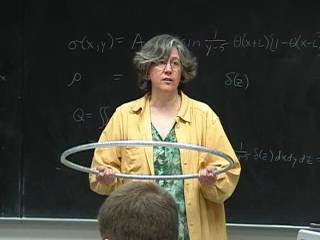Magnetic Vector Potential Due to a Spinning Charged Ring
Highlights of the activity
- This small group activity is designed to help students wrestle with the concepts of current density and magnetic vector potential, as well as provide practice using power series approximations.
- Students are asked to create an integral expression for the magnetic vector potential everywhere in space caused by a ring with total charge $Q$ and radius $R$ spinning with period $T$ and to develop the power series expansion for the potential near the center or far from the ring.
- The wrap-up discussion focuses on how to create an appropriate expression for a vector current density.
Reasons to spend class time on the activity
Surprisingly, it is non-trivial for students to start with Q, R, and T and determine the current density. Although the process does not take long, having students clarify these relationships is important for building understanding. For physicists the picture generated in one’s mind can be make this appear so simple that it is easy to overlook the important connections that students need to make regarding current density before dealing with other aspects of the problem.
This activity allows students to build upon prior understandings and apply them specifically to vector potentials. Even though students had prior experience with this geometry, the instructor found herself discussing with several students the difference between r and r’ and which variables could be held constant during integration.
